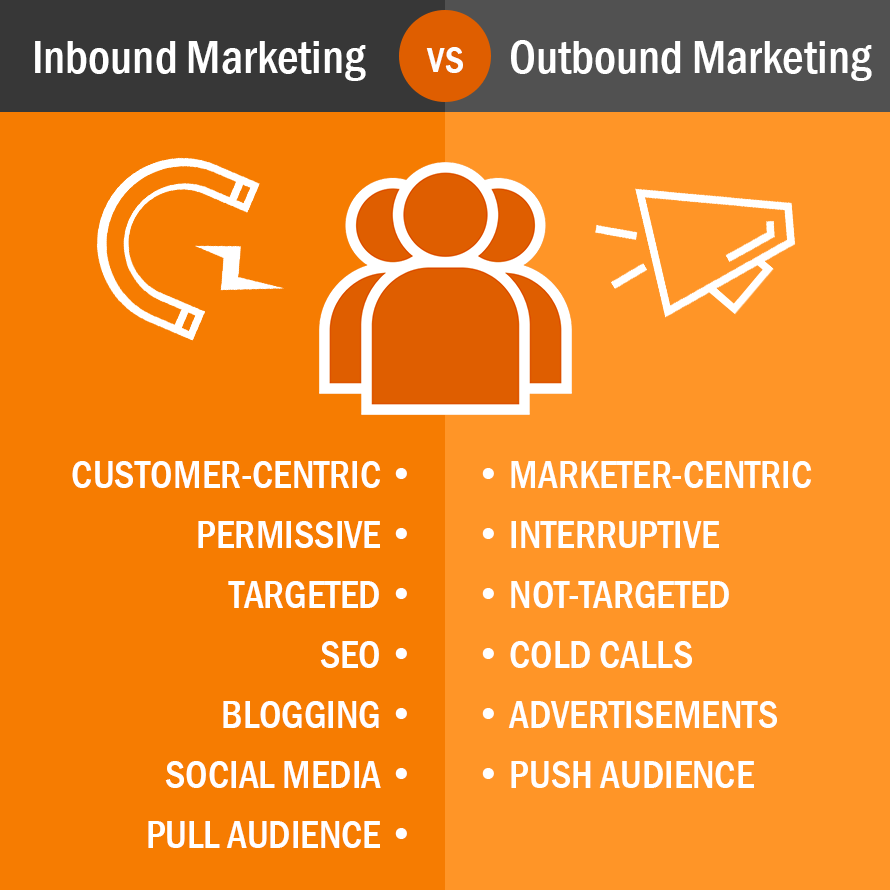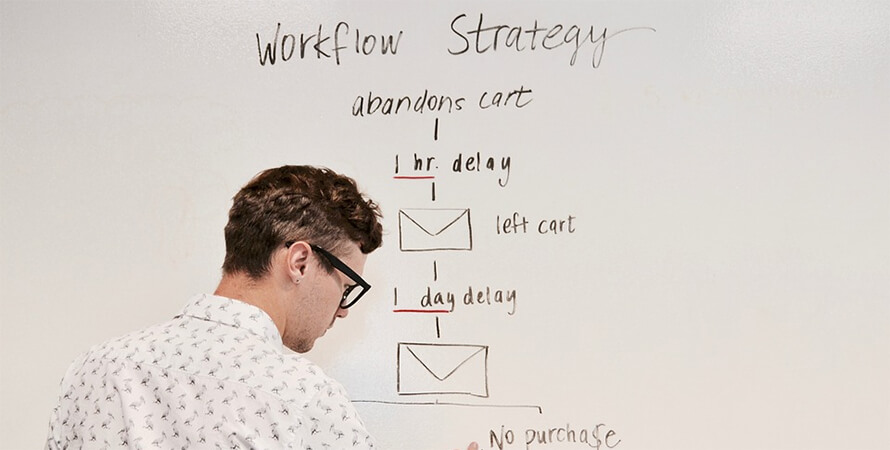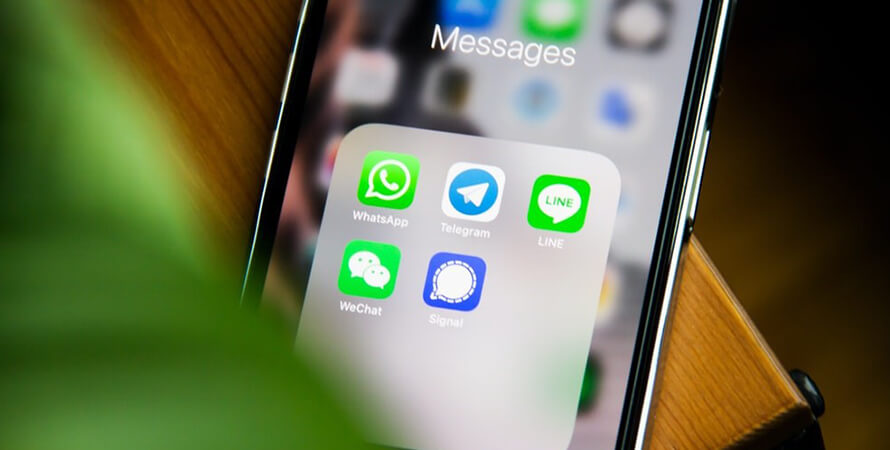
Inbound marketing strategies are the most responsive, integrated, and appropriate means of connecting with potential clients and customers in today's fast-paced world of information.
Traditional marketing strategies have taken an outbound marketing approach, but today's savvy consumers are rejecting such models in favour of intentionally curating their media and connecting with brands that provide more direct value and better align with their sense of identity and self.
Inbound marketing strategies are dynamic and impact every facet of a well-planned marketing approach.
Outbound vs. Inbound Marketing
Outbound marketing is what most people think about when they think of marketing. It consists of billboards, mailers, telemarketing, pop-up internet ads, television ads, and print ads.
The basic philosophy behind outbound marketing strategies is to place advertising content in front of as many potential consumers as possible.
Outbound marketing strategies rely upon high volume because only a tiny percentage of potential consumers who see the advertising will become engaged and explore the brand more fully. Even a smaller percentage will eventually become clients or customers.
Inbound marketing strategies are philosophically different from outbound marketing approaches.
Instead of targeting a broad, general audience with advertisement designed to reach a high volume of potential consumers, inbound marketing is much more focused.
It aims to build brand awareness by providing for the information and entertainment needs of a more focused group of likely consumers who are actively searching for related content.

Another key difference between the two approaches is in how potential consumers arrive at the content.
In outbound marketing strategies, the content is forced onto consumers by being placed where they are likely to be.
In inbound marketing strategies, consumers seek out the content because it provides them something of value that is related to their interests.
Inbound Marketing SEO
Search Engine Optimisation (SEO) for inbound marketing revolves around the character-driven analysis of the profiles of potential consumers.
Since inbound marketing is more targeted than outbound marketing, it often relies on searches that are more specific and intentional.
This means that traditional SEO approaches such as keyword stuffing are no longer sufficient for today's more sophisticated SEO needs.
Inbound marketing SEO strategies need to be dynamic. Content creation and SEO need to go hand-in-hand and be considered simultaneously.
A thorough inbound marketing strategy will include SEO through conducting ongoing keyword data analysis, the building of relationships with influencers in the field, taking a deep dive into analytics and communicating that information clearly across all teams, and collaborating with UX and design teams to ensure content is shared in a way that works for both consumers and search engine algorithms.
Inbound Content Marketing
The most important part of a successful inbound marketing strategy is meaningful, engaging, and timely content.
It is important that the content is accurate, well-written, and useful for consumers.
This content should not just be an advertisement. It should provide consumers with information, insight, or entertainment value.
Content should consider the multiple ways in which contemporary users consume information.

This means that a successful inbound marketing strategy should include multimodal content plans that provide content in long-form, blog posts, white papers, videos, infographics, and more.
Having a multi-pronged content marketing strategy allows a brand to maximise its exposure to potential consumers who are actively seeking out their expertise and influence across different media platforms.
Social Media Marketing and Inbound Content
A successful inbound marketing strategy absolutely must leverage social media presence for content sharing and audience engagement.
A thorough social media marketing strategy includes both organic social media engagement through the brand's profiles and associated pages as well as strategic paid advertising opportunities that are tailored to the specific audience most likely to benefit from the content shared.
Inbound marketing optimisation includes a careful analysis of which social media platforms are most appropriate for the particular industry and content types.
It also includes an ongoing posting schedule that takes into account user engagement trends such as time of day and location.

Successful social media campaigns invite participation from users to create a sense of community among participants and increase organic visibility using existing algorithms within each social media platform.
Marketing Automation for Inbound Strategies
Much like the difference between outbound and inbound marketing strategies as a whole, successful inbound marketing automation strategies must be optimised and carefully considered in order to actively engage potential consumers.
Many marketing automation strategies fail. The problem is that too many brands focus on buying or generating mailing lists without considering how to optimise their inbound content for use with those assets.
The result is a low ROI or even a loss.
A successful marketing automation strategy is holistic and considers the way that leads interact with the brand across all platforms rather than just email.

By optimising automated content and adjusting it to fit the evolving needs of a complex audience, inbound marketing strategies can be applied to automated email campaigns in a way that does more than simply generate clicks.
It will actively increase leads' interest and engagement, building brand awareness, loyalty, and conversions.
Continuous Improvement Cycles for Inbound Marketing
Potential consumers are dynamic individuals whose needs, interests, and habits change over time.
This means that any successful marketing strategy (inbound or outbound) must take into account the changing needs of the target audience.
In order to be adaptive and able to respond to changes in market trends or shifting consumer demographics, brands must adopt a continuous improvement cycle.

Integrating inbound marketing into that cycle of continuous improvement means having a plan to collect, analyse, and disseminate information in a way that is timely and meaningful.
The most effective inbound marketing strategies are consistently analysed for their effectiveness and incorporated into the brand's overall plan for improvement.
Conclusion:
Switching from a more traditional outbound marketing strategy to an inbound one or simply adding inbound approaches to existing marketing plans is a key component of staying up-to-date and capable of meeting the needs of consumers who expect brands to add value to their lives.
By creating inbound marketing approaches that demonstrate value and meet consumers where they are, brands can generate more viable leads and create a loyal fan base that will propel their marketing efforts forward.
Want to know more about Inbound Marketing?
Like to know more about Search Engine Optimisation (SEO), Content Marketing, Social Media Marketing or even continuously improving your website via Growth-Drive Design (GDD) to market your brand, gain more traffic, generate more leads and improve conversion rate?







